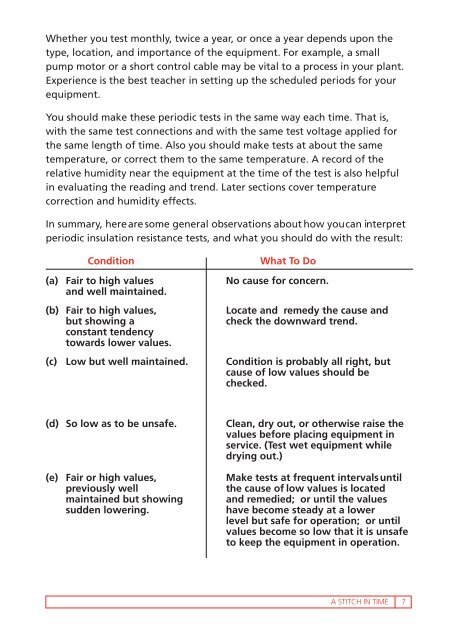“A Stitch in Time...”
You also want an ePaper? Increase the reach of your titles
YUMPU automatically turns print PDFs into web optimized ePapers that Google loves.
Whether you test monthly, twice a year, or once a year depends upon the<br />
type, location, and importance of the equipment. For example, a small<br />
pump motor or a short control cable may be vital to a process <strong>in</strong> your plant.<br />
Experience is the best teacher <strong>in</strong> sett<strong>in</strong>g up the scheduled periods for your<br />
equipment.<br />
You should make these periodic tests <strong>in</strong> the same way each time. That is,<br />
with the same test connections and with the same test voltage applied for<br />
the same length of time. Also you should make tests at about the same<br />
temperature, or correct them to the same temperature. A record of the<br />
relative humidity near the equipment at the time of the test is also helpful<br />
<strong>in</strong> evaluat<strong>in</strong>g the read<strong>in</strong>g and trend. Later sections cover temperature<br />
correction and humidity effects.<br />
In summary, here are some general observations about how you can <strong>in</strong>terpret<br />
periodic <strong>in</strong>sulation resistance tests, and what you should do with the result:<br />
Condition<br />
(a) Fair to high values<br />
and well ma<strong>in</strong>ta<strong>in</strong>ed.<br />
(b) Fair to high values,<br />
but show<strong>in</strong>g a<br />
constant tendency<br />
towards lower values.<br />
(c) Low but well ma<strong>in</strong>ta<strong>in</strong>ed.<br />
What To Do<br />
no cause for concern.<br />
locate and remedy the cause and<br />
check the downward trend.<br />
Condition is probably all right, but<br />
cause of low values should be<br />
checked.<br />
(d) So low as to be unsafe.<br />
(e) Fair or high values,<br />
previously well<br />
ma<strong>in</strong>ta<strong>in</strong>ed but show<strong>in</strong>g<br />
sudden lower<strong>in</strong>g.<br />
Clean, dry out, or otherwise raise the<br />
values before plac<strong>in</strong>g equipment <strong>in</strong><br />
service. (Test wet equipment while<br />
dry<strong>in</strong>g out.)<br />
Make tests at frequent <strong>in</strong>tervals until<br />
the cause of low values is located<br />
and remedied; or until the values<br />
have become steady at a lower<br />
level but safe for operation; or until<br />
values become so low that it is unsafe<br />
to keep the equipment <strong>in</strong> operation.<br />
A STITCH IN TIME



